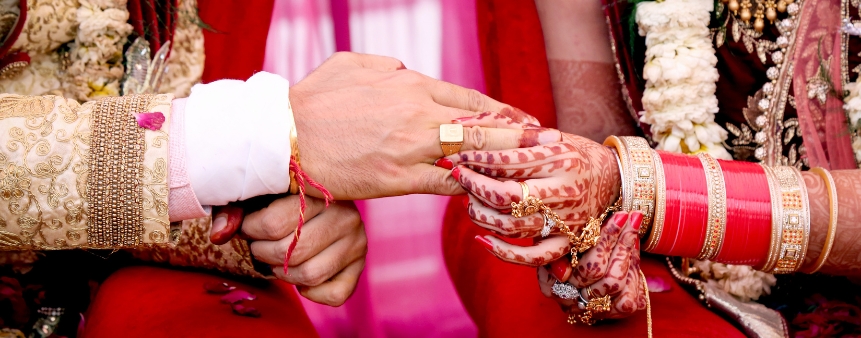Talk to India's best Astrologers
First Consultation at ₹1 only
Login
Enter your mobile number
When one thinks of Kerala, he thinks of peace and beauty. The same emotion is attached to the weddings that are arranged in Kerala. It is a simple, sober wedding consisting of some prosperous rituals and very soft music that gives the soul serenity more than hyper-activeness. They are a mixture of Hindu, Muslim and Christian weddings, and that is all the more reason why weddings in Kerala look so diverse. The profound reasoning behind the rituals performed during a Kerala wedding is mentioned below.
The Kerala Hindu wedding rituals occur in three stages: pre-wedding, marriage day, and post-wedding. The various rituals and customs performed during the wedding have spiritual and cultural meanings. For example, the Mangalayam and Sindoor symbolise the sacredness of the marriage and the groom's commitment to his wife. The Saat Phere signifies the seven vows the couple takes to lead a life together filled with love, trust and mutual respect.
In a traditional Kerala Hindu marriage, several pre-wedding rituals are performed before the wedding ceremony. These rituals are steeped in cultural and religious significance and are vital to wedding celebrations.
Muhurtham
First on the list of Kerala wedding rituals is Muhurtham. This ritual is held to fix a shubh muhurat, a feasible date and time for the Malayali marriage. First, the kundli of the bride and groom is matched, and if they show no obstacle, they are declared a match, and then a date is decided for the marriage to take place.
Nischayam
This ritual is held to declare the wedding officially. An engagement ceremony also takes place so that the couple marry each other.
Mehendi Ceremony

In this ceremony, like any other Mehendi ceremony, the bride chooses a pattern for her wedding, and her aunts put the design on her hand using henna. There are also several dance and music performances made by married aunts.
Madhuparkam
The next ritual in a Malayali wedding is Madhuparkam.
During the wedding day, this ritual is performed by the bride's father upon the groom's arrival at the venue. In Hindu traditions, a son-in-law or groom is treated no less than a god. This is why during the Malayalam wedding, the bride's father washes the feet of the groom as a sign of respect. The bride is not supposed to wear the saree according to her house on the wedding day. Instead, after the Madhuparkam ceremony, it is the groom who gives a white coloured saree with red borders to the bride to be worn on the wedding day.
Sparsham
Post the Madhuparkam, the Sparsham ceremony takes place. In this particular ceremony, the bride and groom sit on a platform facing each other, while the priest or pandit chants prayers and asks the bride to put rice in Agni or the sacred fire. It is believed that when the bride pours rice into the sacred fire, she is warding off the evil spirits and asking for blessings for her long and happy married life. After that, the groom comes into action. In the sparsham ritual, the groom makes the bride touch a grinding stone. In other words, he asks the bride to leave behind her maternal house and life here and start a new chapter with him.
Dakshini Kodukkal
In this ceremony, the Malyali bride and groom, take blessings from their elders and ask them to shower with wishes for a happy married life.
Kanyadaan
This sets the onset of the leading wedding ceremony in Kerala. First, the bride's father washes the groom's feet, and the aunts bring the groom to the mandap. The ceremony begins when the Pandit starts chanting mantras and prayers for the holy union of the bride and groom. Then the bride and the groom take pheras around the fire. Once this is done, the bride’s father gives the mangalsutra to the groom, and the groom ties it around the bride’s neck, symbolising that her father is now handing over his daughter to the groom, and now he must be responsible for her well-being.
Pudamuri
To ensure the wishes of the bride's father, this ceremony takes place, wherein the groom gifts a saree to his newly wedded wife, promising to take care of her in good and wrong and provide for her just like her father did.
Sadhya
In this ceremony, all guests are treated to a grand celebration and congratulations to the newlywed couple. For this ceremony, all famous dishes are arranged, and the food is served on banana leaves. Then, the guests sit and dine together, enjoying the gala.
In many cultures, such as Malyali, the wedding ceremony is just the beginning of the celebrations, and several post-wedding rituals are traditionally observed.
Griha Pravesh
In this ceremony, the bride enters her in-laws' house for the first time as per the shubh muhurat that is generally planned before. The groom's mother lights oil-lit lamps to replace negative energy with positive ones before the bride enters the house.
The Bridal attire
The saree that a newlywed wife in Kerala wears is known as Kasavu. It is a plain white saree with golden borders. They are also adorned with native jewellery called the Kasumala, which is a necklace that is made out of golden coins. Then there is the Palakka Mothiram, a green necklace that looks like a mango. There is another belt that goes around the bride’s waist, which is called the oddiyanam. The choker used by the bride is called Elakkathali, and then there is Jhuki, another traditional piece of jewellery in a Kerala weddings worn by the wife.
The Groom's attire
The groom’s attire is similar to the bride’s and he is seen wearing a white lungi called Mundu which has golden borders. Furthermore, he also adorns a white scarf known as Melmundu, over his white kurta.